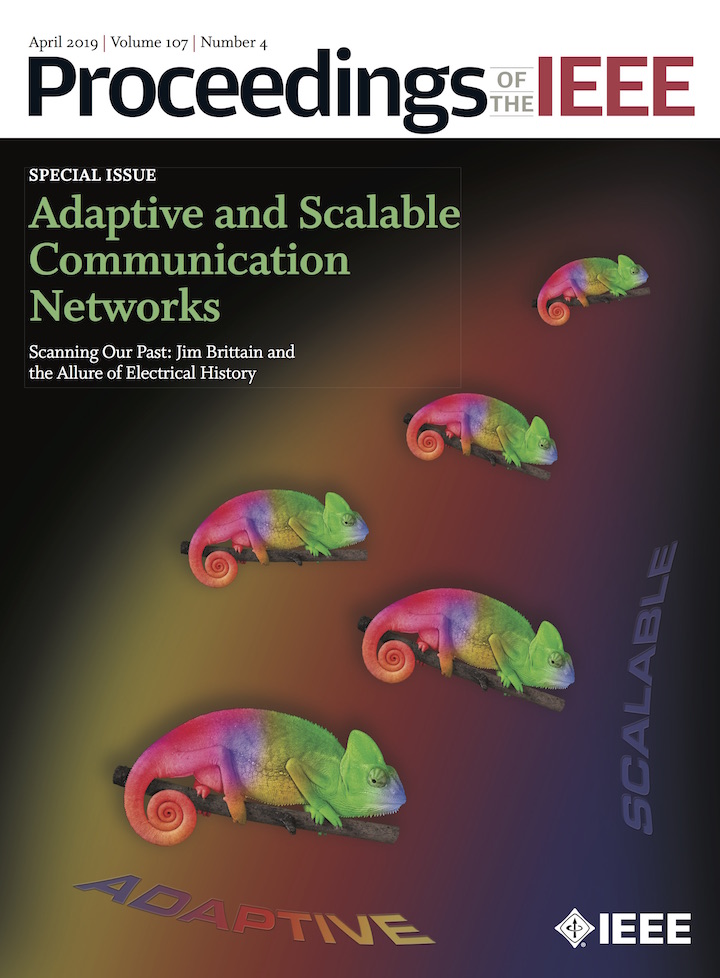2019 Journal Issues April 1, 2019


Special Issue: Adaptive and Scalable Communication Networks
Volume 107, Issue 4
April 2019
Guest Editors




Special Issue Papers
By R. Steinmetz, I. Stavrakakis, C. E. Rothenberg, and B. Koldehofe
By M. Zink, R. Sitaraman, and K. Nahrstedt
This article introduces a novel networking scenario, namely 360◦ video streaming, discussing its challenges, existing approaches, and the research opportunities which it enabled.
By X. Qiao, P. Ren, S. Dustdar, L. Liu, H. Ma, and J. Chen
In the context of mobile augmented reality, this article addresses a challenging network scenario that requires adaptation in the usage of computing, storage, and communication resources.
By P. Aditya, I. E. Akkus, A. Beck, R. Chen, V. Hilt, I. Rimac, K. Satzke, and M. Stein
This article explores a network scenario that is emerging as a different type of a novel cloud computing paradigm in which applications are decomposed into smaller and modular functions.
By F. Metzger, T. Hoßfeld, A. Bauer, S. Kounev, and P. E. Heegaard
This article provides a survey on traffic models for the Internet of Things (IoT), a challenging network scenario comprising highly varying load characteristics and interconnections of devices.
By A. El-Mougy, I. Al-Shiab, and M. Ibnkahla
In the context of the Internet of Things, this article surveys the readiness and interplay of various distinct technologies, including scalable sensing, information-centric networks, and AI, that are likely to be necessary in order to enable personalized IoT networks.
By W. Kellerer, P. Kalmbach, A. Blenk, A. Basta, M. Reisslein, and S. Schmid
This article reviews and analyzes adaptation opportunities and the potential for building scalable communication systems by means of software-defined networking (SDN) and network function virtualization (NFV).
By C. Fiandrino, H. Assasa, P. Casari, and J. Widmer
This article surveys adaptive communication techniques that relate to the coordination of antennas and beams that allow millimeter-wave networks to operate at scale.
By L. Linguaglossa, S. Lange, S. Pontarelli, G. Rétvári, D. Rossi, T. Zinner, R. Bifulco, M. Jarschel, and G. Bianchi
In the network function virtualization, this article surveys ways of realizing network functions in a scalable way. It introduces techniques for hardware and software acceleration that allow for removing inherent bottlenecks in the deployment of network functions.
By H. Jeong and P. Grover
This article reviews adaptive coding techniques for achieving energy efficiency in wireless communications. It analyzes and presents fundamental limits of adaptive coding techniques.
By T. Chen, S. Barbarossa, X. Wang, G. B. Giannakis, and Z.-L. Zhang
In the context of online learning and management policies, this article illustrates ways of dealing with extreme heterogeneity, massive number of devices, and unpredictable dynamics in the context of the Internet of Things.
By J. Liebeherr, M. Valipour, and T. Y. Zhao
This article presents an internetworking approach based on self-organizing application-layer networks, surveying findings related to scalability, the ability to adapt after disruptions, heterogeneous substrate networks, distributed security, and the dynamic creation of network services.
By S. Dobson, D. Hutchison, A. Mauthe, A. Schaeffer-Filho, P. Smith, and J. P. G. Sterbenz
This article reviews and proposes research on the twin fields of self-organization and resilience for networked systems.
By B. Alt, M. Weckesser, C. Becker, M. Hollick, S. Kar, A. Klein, R. Klose, R. Kluge, H. Koeppl, B. Koldehofe, W. R. KhudaBukhsh, M. Luthra, M. Mousavi, M. Mühlhäuser, M. Pfannemüller, A. Rizk, A. Schürr, and R. Steinmetz
This article provides a taxonomy of an adaptation principle, named transition, which aims at increasing the flexibility and scale at which communication networks can be adapted.
Scanning Our Past
By A. Magoun
